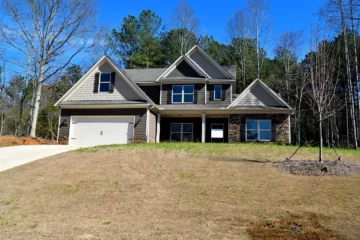
Applying for a mortgage is an important part of buying a house, but many people are confused by this process. One study found that 78% of people thought shopping around for a mortgage was at least moderately challenging, while 29% said securing a mortgage was harder than toilet training a child.
Understanding the mortgage application process can empower you to make smart decisions when securing a home loan. This guide will use $300,000 as a benchmark so you can understand mortgages and calculate your payment options. Learn the process of getting a mortgage on a 300k house and apply this math to your current situation.
Key Factors Influencing Your Monthly Mortgage Payment
A mortgage isn’t a single entity, but rather multiple factors that contribute to your monthly payment. This is good news for homebuyers. It means there are multiple strings you can pull to adjust the payment amount, interest rate, and time frame to pay off the loan.
Once you know the elements that make up your mortgage payment, you can adjust them to meet your needs. Here are the various factors you will work with.
Down Payment
The first number to calculate is your down payment, which is the amount you can put toward your house. In 2023, the median down payment was 15%, which is $45,000 for a $300,000 house. However, first-time buyers had an average down payment of 8% and some loans by the Federal Housing Association (FHA) only require a 4% down payment. This means you could potentially buy your $300k house for as low as $6,000 to $12,000 down.
Smaller down payments are useful for buyers who don’t have a lot saved up, but they usually mean you will have a larger monthly payment. Not only will you have a larger loan, but you might have a higher interest rate because the bank is taking on more risk by giving you a mortgage.
Loan Amount
The loan amount is the price of the house minus your down payment. This will also be known as the principal of the loan. If you buy a $300,000 house and have a $30,000 down payment, your loan amount will be around $270,000.
Your loan amount might be a little higher if your mortgage lender covers your closing costs and other fees related to the loan.
Interest Rate
The interest rate is essentially the cost of the loan. While federal interest rates can provide an estimate of what you will pay for your mortgage, you might pay a higher or lower amount depending on your lender and the risk associated with your loan.
Lower-risk loans tend to have lower interest rates. You can lower your risk level by offering a higher down payment, having a high credit score, and having a low debt-to-income ratio. Even small changes in interest rates can make a big difference.
One example calculated the mortgage differences on a $180,000 loan. A one percent interest rate increase resulted in the buyer paying $37,000 more in interest over the loan. Naturally, this is just an example and your actual interest will depend on your loan size and rate.
Shop around to different lenders to get to know your interest rate options. You can choose a mortgage company that offers favorable rates and safe money on your monthly mortgage payments.
Loan Term
The term covers the time it will take for you to pay off your loan. Most mortgages are either 15-year loans or 30-year loans.
While a 30-year loan has lower monthly payments, it also usually comes with a higher interest rate. Lenders often reward borrowers who want to pay off their loans faster.
Private Mortgage Insurance
If your down payment is less than 20% of the home’s value, you will need to pay private mortgage insurance (PMI). The annual cost of PMI is around 0.22% to 2.25% of your mortgage.
As an example, if you have a $300k house and put down a 10% down payment, your loan amount would be $270k. Your PMI could range from $594 to $6,075 annually. PMI is added to your monthly mortgage payments, so you would pay a fee of $49.50 to $506 on top of your standard loan.
The sooner you reach the 20% ownership threshold on your house, the sooner your lender can cancel the PMI and reduce your monthly payments.
Origination Fees
Banks and other lenders often build fees and other costs into their loans. This is another reason to shop around and meet with different lenders. A bank might offer good loan terms but have excessive fees that drive up your overall costs.
Property Taxes and Homeowners Insurance
Your monthly mortgage payment isn’t your only bill. Some lenders will build monthly tax and homeowners insurance payments into your mortgage.
This prevents you from receiving surprise bills when you own the home. If your lender covers these costs for you, expect your monthly mortgage payments to be higher than if you paid them on your own.
Comparing Loan Terms: 30-Year vs. 15-Year
The loan term is one of the biggest elements of a mortgage payment that you have in your control. If you want a smaller monthly bill, opt for a 30-year mortgage. With this option, you will pay off your debt over three decades.
A 15-year mortgage is shorter. You can pay off your mortgage more aggressively and own a larger percentage of your home faster, but will have a higher bill each month.
The loan terms also affect interest rates. Lenders often have lower interest offers to buyers who want 15-year loans. While your mortgage will be higher with a 15-year loan term, it’s not as simple as doubling the expected monthly payment. Your payment might only be a little larger because of what you save on interest.
It’s worth asking your lenders for both 15-year and 30-year proposals to see what kind of difference they make in your monthly payments.
Understanding Mortgage Types
Your monthly payment calculation will vary depending on the type of mortgage you have. Different loan options come with various risks and opportunities. Here are a few options to consider as you start your mortgage research.
- Conventional loan: this is a standard loan provided by a private lender or bank. It is a standard option for people who want a consistent monthly mortgage payment and have good credit.
- Government-backed loan: this is provided by programs designed to support specific buyers, like first-time homeowners, veterans, and people buying in rural areas. These loans are ideal if you have a small downpayment and an average credit score.
- Jumbo loan: this is a large loan for buyers who are looking in high-cost-of-living areas like San Francisco or Seattle.
- Bridge loan: this is often used when buying one house while selling another. The loan usually only lasts around six months and is designed to bridge a financial gap.
Most buyers use conventional or government-backed mortgage loans. Talk to your lender if you think you will need different loan options to accommodate special cases.
Fixed-Rate vs. Adjustable-Rate Mortgages (ARM)
When you apply for a conventional loan, you can decide whether you want a fixed-rate mortgage or an adjustable-rate option. A fixed-rate loan has the same monthly mortgage payment from the start of the loan to the end. Your lender might adjust your payments based on your taxes and insurance, but there won’t be any adjustments based on interest rates.
People often prefer fixed-rate options because of their stability. You know what to expect from your mortgage payment from month to month. These loans are also preferred when you can lock in a lower interest rate. Rates can increase but they won’t affect you.
An adjustable-rate mortgage (ARM) varies based on interest rate trends. When interest rates are low, your monthly payment is low. When they increase, so does your payment. ARMs are considered riskier because your monthly payments could increase dramatically when rates climb. However, they are sometimes preferred when interest rates are high because your monthly payments will decrease when rates drop.
Determine the level of risk you are comfortable with in your monthly mortgage payments. A fixed-rate mortgage is ideal if you want your monthly payment to stay the same, but an ARM could be a good option if you are buying when interest rates are high.
Calculating the Monthly Payment for a $300K Mortgage
Once you have a clear understanding of all the factors involved in calculating a mortgage, you can estimate your monthly mortgage payments and determine whether a $300k house is in your price range. Follow these steps and use this math as an example to estimate your mortgage costs.
- Start with the home price. For the sake of simplicity, assume you are buying a $300k house.
- Calculate your down payment. You might not want to put all of your money into the down payment. Set aside a few thousand dollars for home repairs and emergency expenses. A 20% down payment on a $300k house is $60,000, which means your loan amount is $240,000.
- Determine whether you need PMI. If your down payment is less than 20%, estimate that you will pay 1% of your loan amount annually for PMI. For a $300k house with a 10% down payment, your PMI is $2,700 or $225 monthly.
- Check interest rates. Review the interest rates in your area and how they change based on the loan terms.
- Estimate property taxes tax and insurance costs. Your lender should be able to provide estimates on the tax bills and homeowners insurance rates of the homes you are interested in.
- Don’t forget the closing costs. Buyers can expect to pay between 2% and 6% of the loan amount in closing costs. For a $270,000 loan, closing costs could range from $5,400 to $16,200.
Multiple online calculators will help you estimate your monthly mortgage payments. Turn to these if you don’t want to do the math yourself. You can also request loan estimates from lenders to see your estimated monthly payments.
Affordability: How Much Income You Need
The first step when you want to buy a home is calculating the monthly mortgage payment. Once you know the mortgage on a 300k house, you can determine whether it is in your price range.
When you apply for a loan, mortgage lenders will ask for proof of income to calculate your debt-to-income ratio (DTI). This is the amount of debt you pay compared to your gross monthly income (what you take home before taxes). Most lenders won’t approve a loan that exceeds 43% of your DTI and many banks set DTI caps of 36%. Here are two examples to consider:
- A buyer receives an annual salary of $60,000 before taxes, which is $5,000 per month. They don’t have any student loans, car payments, or other debt. Lenders are willing to approve a maximum mortgage payment of $1,800 per month (36% DTI).
- Another buyer has the same salary of $5,000 per month. However, they also have a $250 monthly car payment and a $550 monthly student loan payment. Lenders are willing to approve a maximum mortgage payment of $1,000 per month (DTI).
There are two ways to lower your DTI: you can increase your income and lower your debt. Some buyers will spend a year aggressively paying off student loans or car payments to eliminate this debt from their lives. Others wait until they get a promotion or find a new job and have enough income to cover all of their expenses. You also might be able to co-sign a loan with your partner so you can report two incomes to your lender.
The Mortgage Application Process
If you feel confident in your monthly mortgage payment estimates, you can start the application process. Here is what it will look like from your first contact with lenders to your closing date.
- Get pre-qualified: talk to a few lenders and review your finances to get an idea of your ideal loan size. You usually do not have to provide documentation of your finances during this conversation.
- Start looking at houses: tour homes in your price range and desired area. Find one you would like to make an offer on.
- Get pre-approved: send the house to your lender and ask for pre-approval on the loan. This will make your home offer stronger. You will need to provide financial documents to your lender (like tax returns, pay stubs, and bank statements) to gain pre-approval.
- Bid on the house: submit an offer to the homeowner and include your lender’s pre-approval letter.
- Continue to send financial documentation to your lender: you will need to provide a detailed picture of your finances to your lender during the underwriting process. Include as much information as you have to meet your closing deadline.
- Avoid any decisions that would affect your credit: don’t take out any loans or credit cards at this time. Wait until you close to make any big purchases that could affect your finances.
- Get cleared to close: if your finances are in order, you will both be cleared to close. You will submit your down payment to the lender and they will work with the title company to prepare the paperwork for the closing appointment.
Completing a mortgage application usually takes 20 to 60 days depending on the house and lender. During this time, expect to talk to your lender daily as they work through the underwriting process.
Comparing $300K to Median Home Prices
Once all of your monthly payment calculations are complete and your finances are in order, you can check whether a mortgage on a 300k house is a realistic goal in your area. $300,000 will go farther in some areas than others, which will affect your home search.
At the end of 2023, the median home price in the United States was $417,700. However, home prices vary significantly by state, city, and even neighborhood. Here are a few median home prices in a handful of sample states that display how different costs can be:
- Iowa: $205,139
- New Mexico: $287,752
- Tennessee: $304,617
- Virginia: $370,134
- Oregon: $480,251
- Massachusetts: $581,414
- California: $737,677
Just by looking at these states, you can see that a $300k house is reasonable in some areas but not others. The data also changes on a city level. Tennessee might seem affordable, but housing prices in Nashville are exceptionally high compared to the rest of the state. The same can be said for Portland in Oregon compared to other parts of the region.
To find a home in your area, list your must-have amenities. These are usually the number of bathrooms and bedrooms along with the location. See what your desired properties sell for to see whether budgeting for a mortgage on a 300k house is reasonable.
Work with a Realtor to Secure a Mortgage on a 300k House
While calculating your mortgage on a 300k house is useful when starting the home search process, you don’t need to be a financial expert to find a home. Your Realtor can help you review your finances and estimate the type of mortgage you can afford. They can also help you get pre-qualified for a mortgage loan to speed up the process once you start looking at houses. Your real estate agent is on your side and ready to support you through this journey.
Check out FastExpert to find an agent who can help you buy a $300k house. You can look at Realtors who buy and sell properties for clients at similar levels. You can also interview these agents to make sure they are right for you. Visit FastExpert today and take the first steps toward buying a house.
- SEO Powered Content & PR Distribution. Get Amplified Today.
- PlatoData.Network Vertical Generative Ai. Empower Yourself. Access Here.
- PlatoAiStream. Web3 Intelligence. Knowledge Amplified. Access Here.
- PlatoESG. Carbon, CleanTech, Energy, Environment, Solar, Waste Management. Access Here.
- PlatoHealth. Biotech and Clinical Trials Intelligence. Access Here.
- Source: https://www.fastexpert.com/blog/mortgage-on-a-300k-house/
- :has
- :is
- :not
- $UP
- 000
- 15%
- 2%
- 20
- 200
- 2023
- 300K
- 400
- 50
- 60
- 700
- 800
- a
- Able
- accommodate
- actual
- added
- adjust
- adjustments
- affect
- afford
- affordable
- Agent
- aggressively
- All
- along
- also
- amenities
- amount
- an
- and
- annual
- Annually
- Another
- any
- Application
- Apply
- appointment
- approve
- ARE
- AREA
- areas
- ARM
- arms
- around
- AS
- aside
- ask
- asking
- associated
- Association
- assume
- At
- average
- Bank
- Banks
- based
- BE
- because
- before
- Benchmark
- between
- Big
- Biggest
- Bill
- Bills
- borrowers
- both
- BRIDGE
- budgeting
- build
- but
- buy
- BUYER..
- buyers
- Buying
- by
- calculate
- calculated
- calculating
- calculation
- calculations
- CAN
- caps
- car
- Cards
- cases
- challenging
- change
- Changes
- check
- child
- Choose
- City
- clear
- clients
- climb
- Close
- closing
- COM
- come
- comes
- comfortable
- company
- compared
- complete
- confident
- confused
- Consider
- considered
- consistent
- contact
- contribute
- control
- conventional
- Conversation
- Cost
- Costs
- could
- cover
- covers
- credit
- Credit Cards
- Current
- daily
- data
- Date
- Days
- deadline
- Debt
- decades
- decide
- decisions
- decrease
- depend
- Depending
- designed
- desired
- detailed
- Determine
- difference
- differences
- different
- Display
- do
- documentation
- documents
- does
- dollars
- Dont
- doubling
- down
- dramatically
- drive
- Drop
- DTI
- during
- each
- either
- elements
- eliminate
- emergency
- empower
- end
- enough
- entity
- essentially
- estate
- estate agent
- estimate
- estimated
- estimates
- Even
- example
- examples
- exceeds
- exceptionally
- excessive
- expect
- expected
- expenses
- expert
- factors
- faster
- favorable
- Federal
- fee
- feel
- Fees
- few
- Finances
- financial
- Find
- First
- first contact
- first steps
- follow
- For
- found
- FRAME
- Francisco
- from
- Gain
- gap
- get
- getting
- Giving
- Go
- goal
- good
- gross
- guide
- had
- handful
- harder
- Have
- having
- help
- here
- High
- higher
- Home
- Homes
- House
- houses
- housing
- How
- However
- http
- HTTPS
- idea
- ideal
- if
- important
- in
- include
- Income
- Increase
- influencing
- information
- insurance
- interest
- INTEREST RATE
- Interest Rates
- interested
- into
- involved
- IT
- Job
- journey
- jpg
- just
- Kind
- Know
- known
- large
- larger
- LEARN
- least
- lender
- lenders
- less
- less than 20%
- letter
- Level
- levels
- like
- List
- little
- Lives
- loan
- Loans
- location
- lock
- Look
- look like
- looking
- Lot
- Low
- lower
- make
- many
- many people
- math
- maximum
- mean
- means
- Meet
- Mexico
- might
- money
- Month
- monthly
- months
- more
- Mortgage
- Mortgages
- most
- much
- multiple
- Must-Have
- Nashville
- naturally
- Need
- needs
- New
- news
- number
- of
- off
- offer
- offering
- Offers
- often
- on
- once
- ONE
- online
- only
- opportunities
- opt
- Option
- Options
- or
- order
- Other
- Others
- out
- over
- overall
- own
- ownership
- paid
- paperwork
- part
- partner
- parts
- Pay
- paying
- payment
- payment options
- payments
- People
- per
- percent
- percentage
- picture
- plato
- Plato Data Intelligence
- PlatoData
- pmi
- Portland
- potentially
- prefer
- preferred
- Prepare
- prevents
- price
- Prices
- Principal
- private
- process
- Programs
- promotion
- proof
- properties
- property
- Proposals
- provide
- provided
- purchases
- put
- range
- Rate
- Rates
- rather
- ratio
- reach
- ready
- real
- real estate
- realistic
- realtor
- reason
- reasonable
- receives
- receiving
- reduce
- region
- related
- repairs
- report
- request
- require
- research
- REST
- resulted
- returns
- review
- Reward
- right
- Risk
- riskier
- risks
- Rural
- Rural Areas
- safe
- Said
- sake
- salary
- same
- sample
- San
- San Francisco
- Save
- saved
- score
- Search
- Seattle
- secure
- securing
- see
- seem
- sell
- Selling
- send
- set
- Shop
- Shopping
- should
- side
- significantly
- similar
- Simple
- simplicity
- single
- situation
- SIX
- Six months
- Size
- small
- smaller
- smart
- So
- some
- sometimes
- special
- specific
- speed
- spend
- Stability
- standard
- start
- Starting
- State
- statements
- States
- stay
- Step
- Steps
- stronger
- Student
- submit
- support
- sure
- surprise
- Take
- takes
- taking
- Talk
- tax
- Taxes
- tend
- term
- terms
- than
- that
- The
- The State
- their
- Them
- There.
- These
- they
- Think
- this
- thought
- thousand
- three
- threshold
- Through
- time
- Title
- to
- today
- Toilet
- top
- Tour
- toward
- Training
- Trends
- TURN
- two
- type
- understand
- understanding
- underwriting
- United
- United States
- until
- use
- used
- useful
- usually
- value
- various
- vary
- Veterans
- Visit
- vs
- wait
- want
- was
- ways
- What
- when
- whether
- which
- while
- WHO
- will
- willing
- with
- Work
- worth
- would
- year
- you
- Your
- yourself
- zephyrnet













